An Analysis of Consumer Behaviour and Decision-Making in Tourism
VerifiedAdded on 2023/01/19
|13
|3924
|40
Report
AI Summary
This report provides a comprehensive analysis of consumer behavior within the tourism industry. It examines various factors influencing consumer decisions, including personal, social, and psychological elements, and explores how technology, such as smartphones, social media, and online platforms, shapes consumer trends. The report outlines the stages of the consumer decision-making journey, from need recognition to post-purchase evaluation, and emphasizes the importance of mapping the path to purchase for marketers. It also compares the key differences between B2C and B2B contexts within the hospitality sector, using tourism examples. Furthermore, the report discusses different approaches to market research and how marketers can influence various stages of the tourism consumer's journey, offering valuable insights for understanding and targeting consumers effectively.
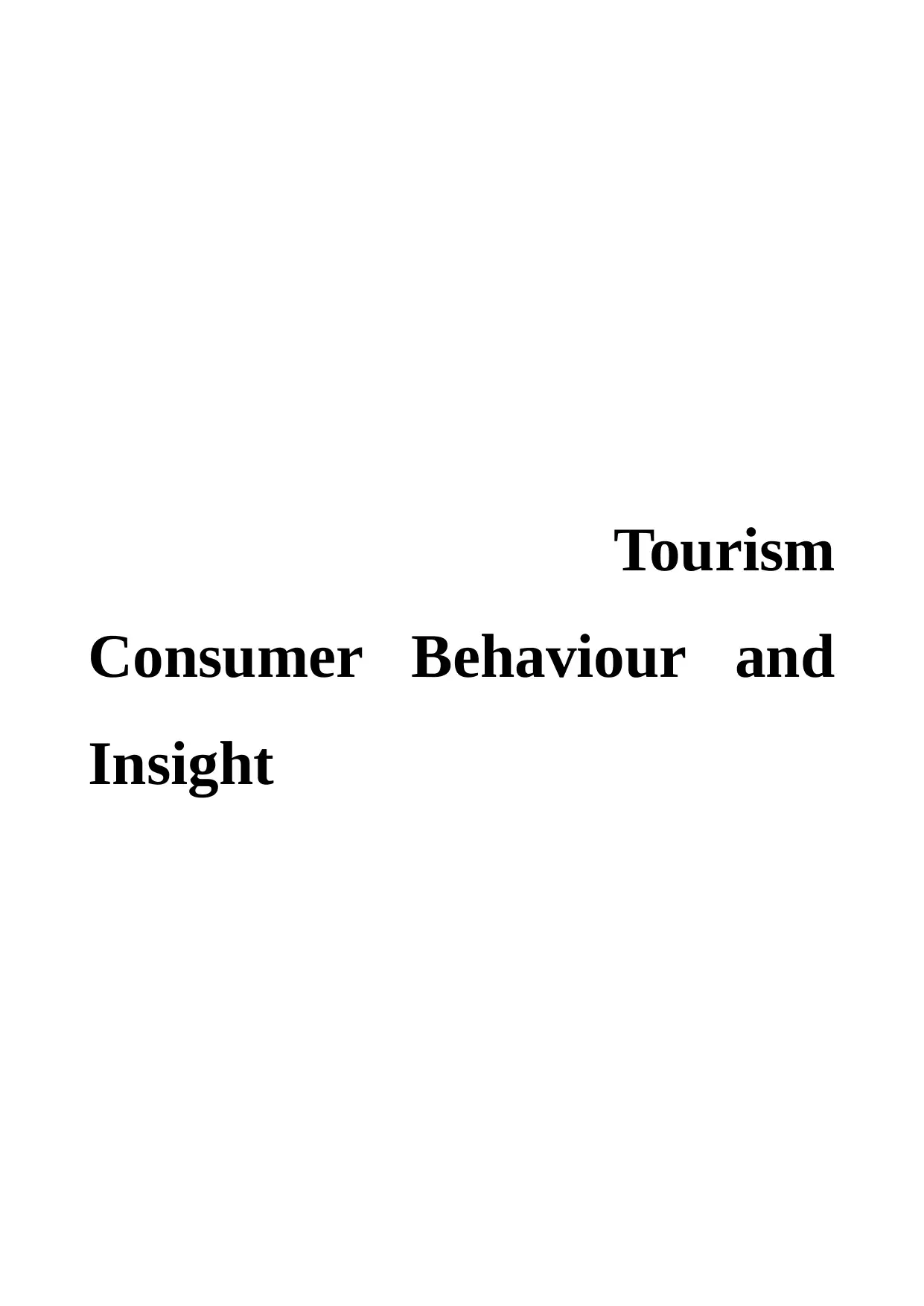
Tourism
Consumer Behaviour and
Insight
Consumer Behaviour and
Insight
Paraphrase This Document
Need a fresh take? Get an instant paraphrase of this document with our AI Paraphraser
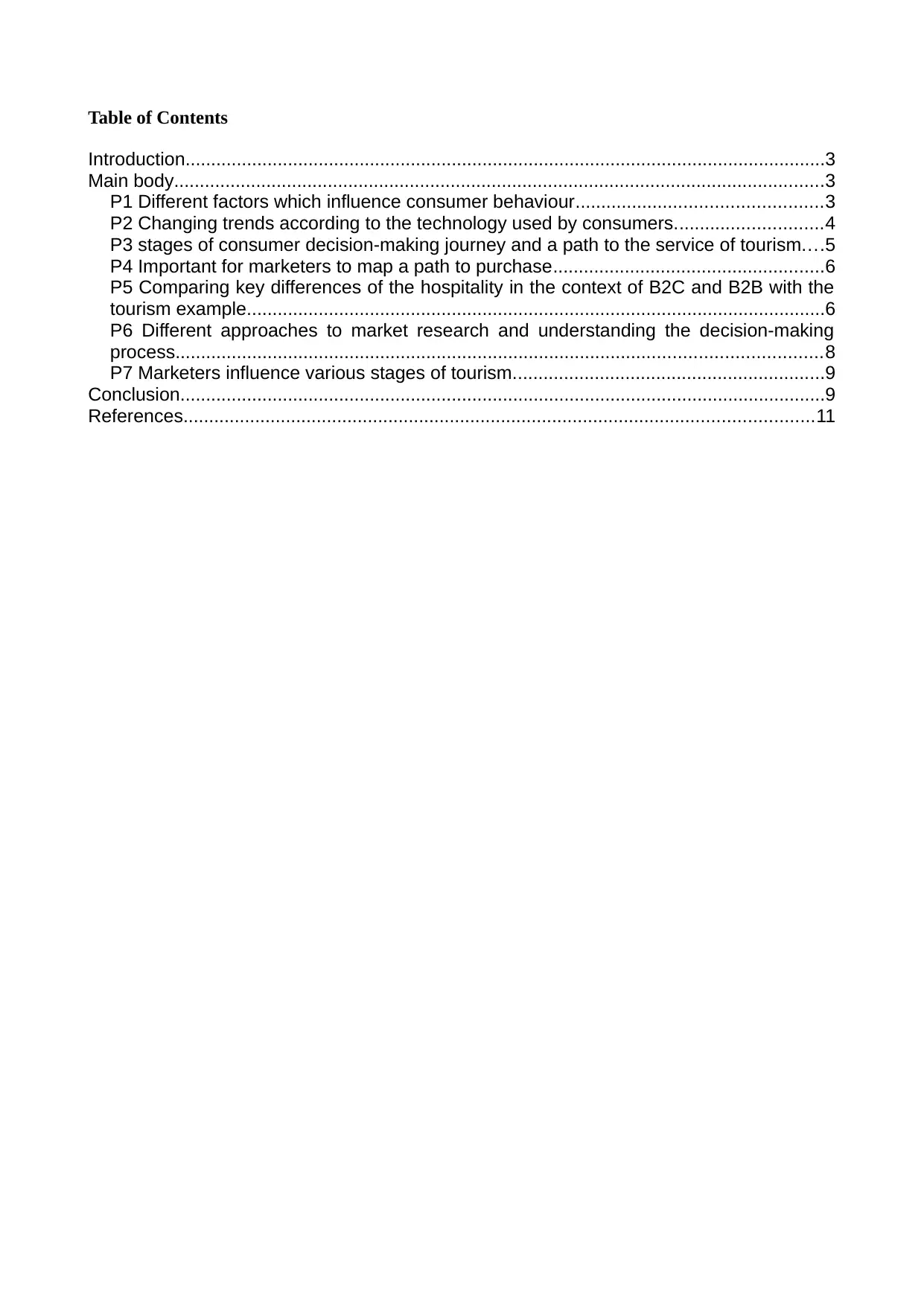
Table of Contents
Introduction.............................................................................................................................3
Main body...............................................................................................................................3
P1 Different factors which influence consumer behaviour................................................3
P2 Changing trends according to the technology used by consumers.............................4
P3 stages of consumer decision-making journey and a path to the service of tourism....5
P4 Important for marketers to map a path to purchase.....................................................6
P5 Comparing key differences of the hospitality in the context of B2C and B2B with the
tourism example.................................................................................................................6
P6 Different approaches to market research and understanding the decision-making
process..............................................................................................................................8
P7 Marketers influence various stages of tourism.............................................................9
Conclusion..............................................................................................................................9
References...........................................................................................................................11
Introduction.............................................................................................................................3
Main body...............................................................................................................................3
P1 Different factors which influence consumer behaviour................................................3
P2 Changing trends according to the technology used by consumers.............................4
P3 stages of consumer decision-making journey and a path to the service of tourism....5
P4 Important for marketers to map a path to purchase.....................................................6
P5 Comparing key differences of the hospitality in the context of B2C and B2B with the
tourism example.................................................................................................................6
P6 Different approaches to market research and understanding the decision-making
process..............................................................................................................................8
P7 Marketers influence various stages of tourism.............................................................9
Conclusion..............................................................................................................................9
References...........................................................................................................................11
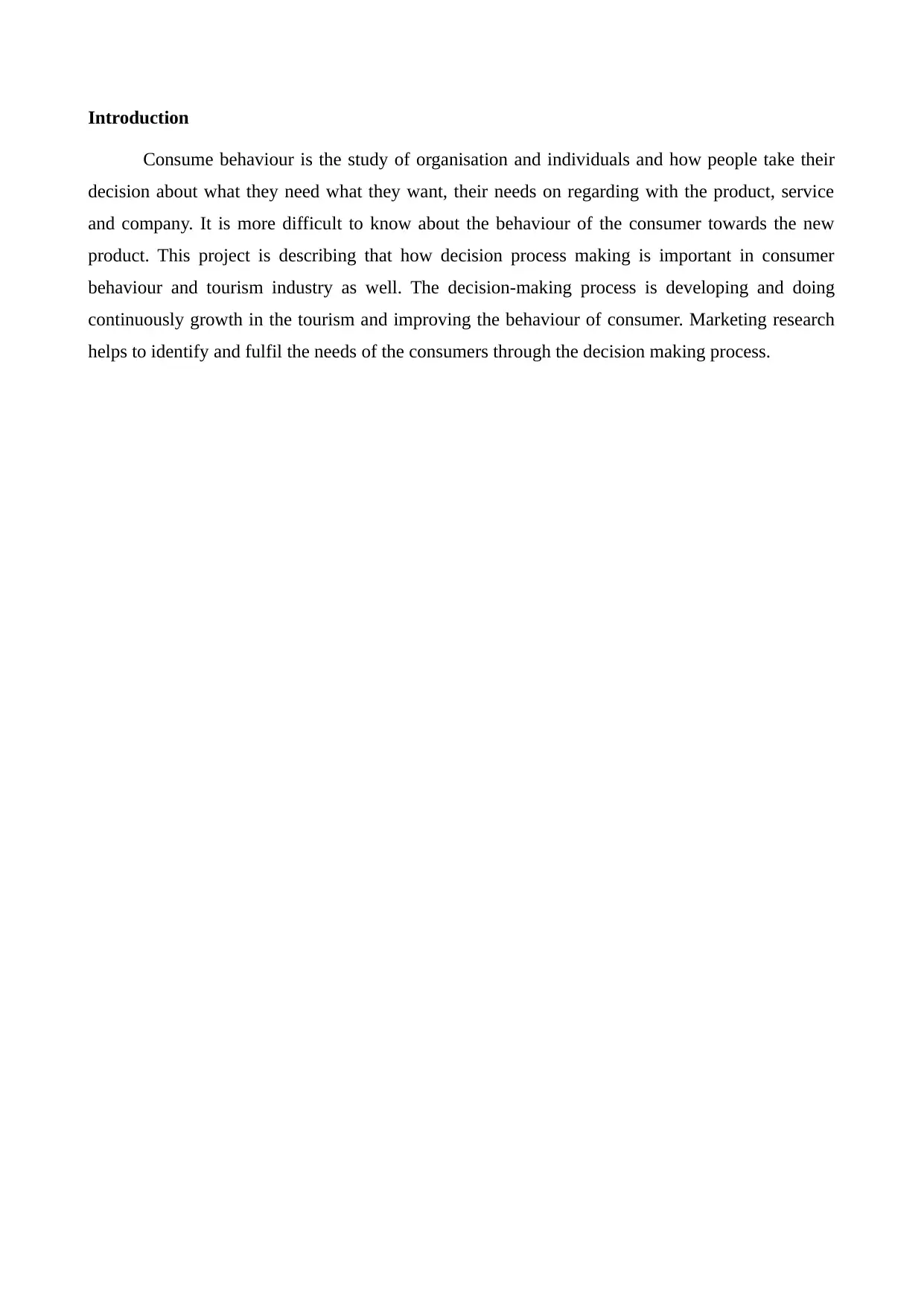
Introduction
Consume behaviour is the study of organisation and individuals and how people take their
decision about what they need what they want, their needs on regarding with the product, service
and company. It is more difficult to know about the behaviour of the consumer towards the new
product. This project is describing that how decision process making is important in consumer
behaviour and tourism industry as well. The decision-making process is developing and doing
continuously growth in the tourism and improving the behaviour of consumer. Marketing research
helps to identify and fulfil the needs of the consumers through the decision making process.
Consume behaviour is the study of organisation and individuals and how people take their
decision about what they need what they want, their needs on regarding with the product, service
and company. It is more difficult to know about the behaviour of the consumer towards the new
product. This project is describing that how decision process making is important in consumer
behaviour and tourism industry as well. The decision-making process is developing and doing
continuously growth in the tourism and improving the behaviour of consumer. Marketing research
helps to identify and fulfil the needs of the consumers through the decision making process.
⊘ This is a preview!⊘
Do you want full access?
Subscribe today to unlock all pages.

Trusted by 1+ million students worldwide
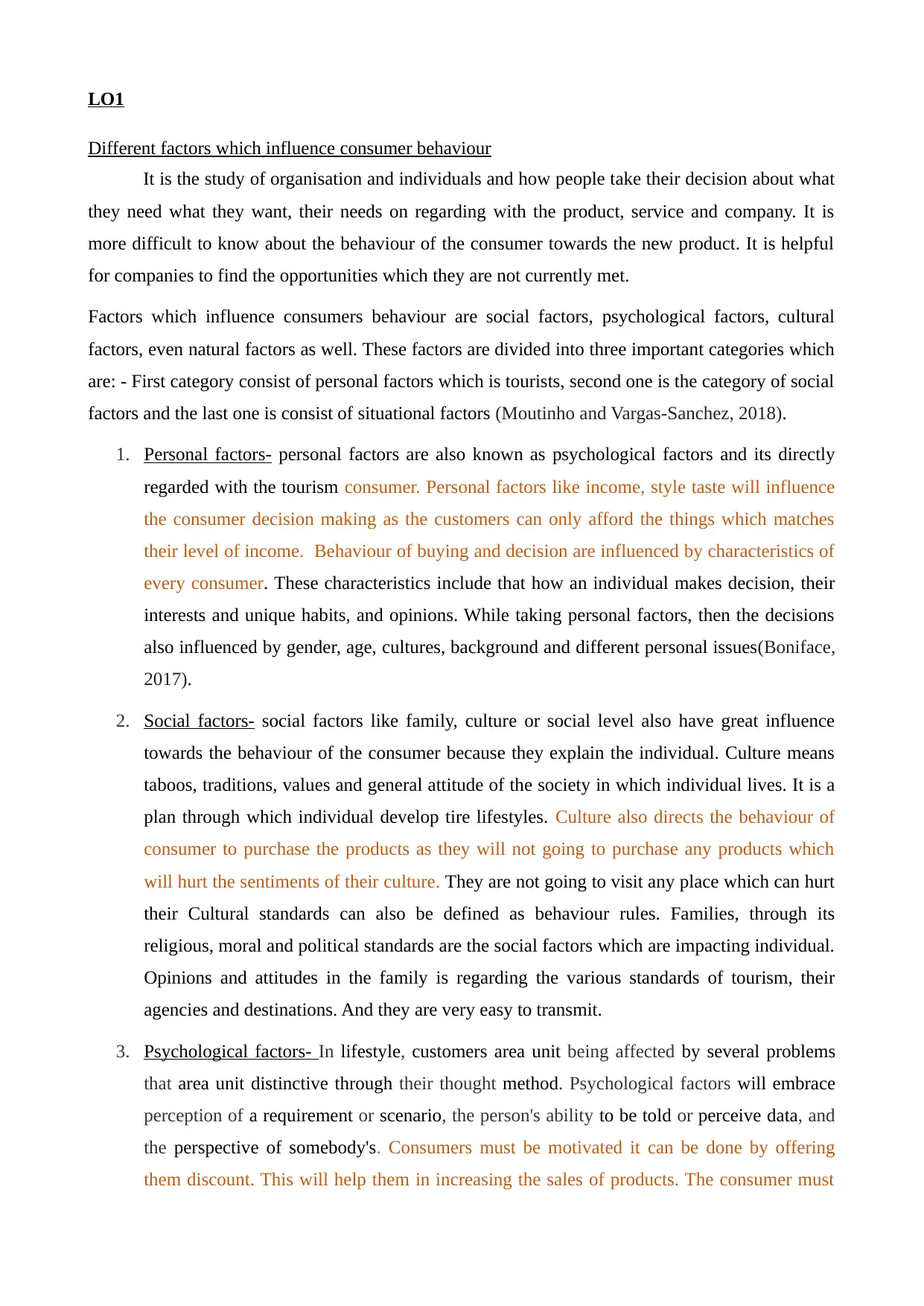
LO1
Different factors which influence consumer behaviour
It is the study of organisation and individuals and how people take their decision about what
they need what they want, their needs on regarding with the product, service and company. It is
more difficult to know about the behaviour of the consumer towards the new product. It is helpful
for companies to find the opportunities which they are not currently met.
Factors which influence consumers behaviour are social factors, psychological factors, cultural
factors, even natural factors as well. These factors are divided into three important categories which
are: - First category consist of personal factors which is tourists, second one is the category of social
factors and the last one is consist of situational factors (Moutinho and Vargas-Sanchez, 2018).
1. Personal factors- personal factors are also known as psychological factors and its directly
regarded with the tourism consumer. Personal factors like income, style taste will influence
the consumer decision making as the customers can only afford the things which matches
their level of income. Behaviour of buying and decision are influenced by characteristics of
every consumer. These characteristics include that how an individual makes decision, their
interests and unique habits, and opinions. While taking personal factors, then the decisions
also influenced by gender, age, cultures, background and different personal issues(Boniface,
2017).
2. Social factors- social factors like family, culture or social level also have great influence
towards the behaviour of the consumer because they explain the individual. Culture means
taboos, traditions, values and general attitude of the society in which individual lives. It is a
plan through which individual develop tire lifestyles. Culture also directs the behaviour of
consumer to purchase the products as they will not going to purchase any products which
will hurt the sentiments of their culture. They are not going to visit any place which can hurt
their Cultural standards can also be defined as behaviour rules. Families, through its
religious, moral and political standards are the social factors which are impacting individual.
Opinions and attitudes in the family is regarding the various standards of tourism, their
agencies and destinations. And they are very easy to transmit.
3. Psychological factors- In lifestyle, customers area unit being affected by several problems
that area unit distinctive through their thought method. Psychological factors will embrace
perception of a requirement or scenario, the person's ability to be told or perceive data, and
the perspective of somebody's. Consumers must be motivated it can be done by offering
them discount. This will help them in increasing the sales of products. The consumer must
Different factors which influence consumer behaviour
It is the study of organisation and individuals and how people take their decision about what
they need what they want, their needs on regarding with the product, service and company. It is
more difficult to know about the behaviour of the consumer towards the new product. It is helpful
for companies to find the opportunities which they are not currently met.
Factors which influence consumers behaviour are social factors, psychological factors, cultural
factors, even natural factors as well. These factors are divided into three important categories which
are: - First category consist of personal factors which is tourists, second one is the category of social
factors and the last one is consist of situational factors (Moutinho and Vargas-Sanchez, 2018).
1. Personal factors- personal factors are also known as psychological factors and its directly
regarded with the tourism consumer. Personal factors like income, style taste will influence
the consumer decision making as the customers can only afford the things which matches
their level of income. Behaviour of buying and decision are influenced by characteristics of
every consumer. These characteristics include that how an individual makes decision, their
interests and unique habits, and opinions. While taking personal factors, then the decisions
also influenced by gender, age, cultures, background and different personal issues(Boniface,
2017).
2. Social factors- social factors like family, culture or social level also have great influence
towards the behaviour of the consumer because they explain the individual. Culture means
taboos, traditions, values and general attitude of the society in which individual lives. It is a
plan through which individual develop tire lifestyles. Culture also directs the behaviour of
consumer to purchase the products as they will not going to purchase any products which
will hurt the sentiments of their culture. They are not going to visit any place which can hurt
their Cultural standards can also be defined as behaviour rules. Families, through its
religious, moral and political standards are the social factors which are impacting individual.
Opinions and attitudes in the family is regarding the various standards of tourism, their
agencies and destinations. And they are very easy to transmit.
3. Psychological factors- In lifestyle, customers area unit being affected by several problems
that area unit distinctive through their thought method. Psychological factors will embrace
perception of a requirement or scenario, the person's ability to be told or perceive data, and
the perspective of somebody's. Consumers must be motivated it can be done by offering
them discount. This will help them in increasing the sales of products. The consumer must
Paraphrase This Document
Need a fresh take? Get an instant paraphrase of this document with our AI Paraphraser
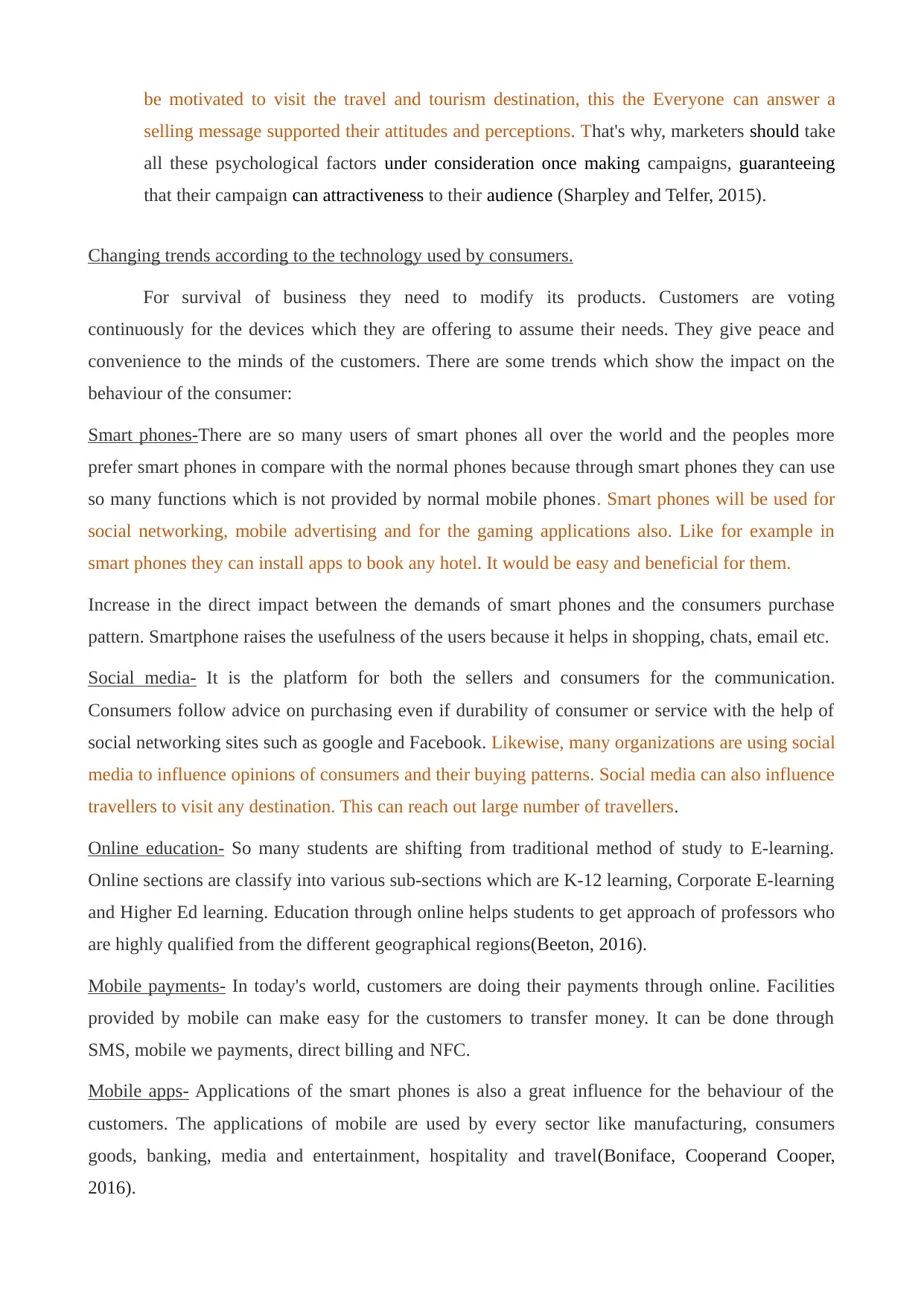
be motivated to visit the travel and tourism destination, this the Everyone can answer a
selling message supported their attitudes and perceptions. That's why, marketers should take
all these psychological factors under consideration once making campaigns, guaranteeing
that their campaign can attractiveness to their audience (Sharpley and Telfer, 2015).
Changing trends according to the technology used by consumers.
For survival of business they need to modify its products. Customers are voting
continuously for the devices which they are offering to assume their needs. They give peace and
convenience to the minds of the customers. There are some trends which show the impact on the
behaviour of the consumer:
Smart phones-There are so many users of smart phones all over the world and the peoples more
prefer smart phones in compare with the normal phones because through smart phones they can use
so many functions which is not provided by normal mobile phones. Smart phones will be used for
social networking, mobile advertising and for the gaming applications also. Like for example in
smart phones they can install apps to book any hotel. It would be easy and beneficial for them.
Increase in the direct impact between the demands of smart phones and the consumers purchase
pattern. Smartphone raises the usefulness of the users because it helps in shopping, chats, email etc.
Social media- It is the platform for both the sellers and consumers for the communication.
Consumers follow advice on purchasing even if durability of consumer or service with the help of
social networking sites such as google and Facebook. Likewise, many organizations are using social
media to influence opinions of consumers and their buying patterns. Social media can also influence
travellers to visit any destination. This can reach out large number of travellers.
Online education- So many students are shifting from traditional method of study to E-learning.
Online sections are classify into various sub-sections which are K-12 learning, Corporate E-learning
and Higher Ed learning. Education through online helps students to get approach of professors who
are highly qualified from the different geographical regions(Beeton, 2016).
Mobile payments- In today's world, customers are doing their payments through online. Facilities
provided by mobile can make easy for the customers to transfer money. It can be done through
SMS, mobile we payments, direct billing and NFC.
Mobile apps- Applications of the smart phones is also a great influence for the behaviour of the
customers. The applications of mobile are used by every sector like manufacturing, consumers
goods, banking, media and entertainment, hospitality and travel(Boniface, Cooperand Cooper,
2016).
selling message supported their attitudes and perceptions. That's why, marketers should take
all these psychological factors under consideration once making campaigns, guaranteeing
that their campaign can attractiveness to their audience (Sharpley and Telfer, 2015).
Changing trends according to the technology used by consumers.
For survival of business they need to modify its products. Customers are voting
continuously for the devices which they are offering to assume their needs. They give peace and
convenience to the minds of the customers. There are some trends which show the impact on the
behaviour of the consumer:
Smart phones-There are so many users of smart phones all over the world and the peoples more
prefer smart phones in compare with the normal phones because through smart phones they can use
so many functions which is not provided by normal mobile phones. Smart phones will be used for
social networking, mobile advertising and for the gaming applications also. Like for example in
smart phones they can install apps to book any hotel. It would be easy and beneficial for them.
Increase in the direct impact between the demands of smart phones and the consumers purchase
pattern. Smartphone raises the usefulness of the users because it helps in shopping, chats, email etc.
Social media- It is the platform for both the sellers and consumers for the communication.
Consumers follow advice on purchasing even if durability of consumer or service with the help of
social networking sites such as google and Facebook. Likewise, many organizations are using social
media to influence opinions of consumers and their buying patterns. Social media can also influence
travellers to visit any destination. This can reach out large number of travellers.
Online education- So many students are shifting from traditional method of study to E-learning.
Online sections are classify into various sub-sections which are K-12 learning, Corporate E-learning
and Higher Ed learning. Education through online helps students to get approach of professors who
are highly qualified from the different geographical regions(Beeton, 2016).
Mobile payments- In today's world, customers are doing their payments through online. Facilities
provided by mobile can make easy for the customers to transfer money. It can be done through
SMS, mobile we payments, direct billing and NFC.
Mobile apps- Applications of the smart phones is also a great influence for the behaviour of the
customers. The applications of mobile are used by every sector like manufacturing, consumers
goods, banking, media and entertainment, hospitality and travel(Boniface, Cooperand Cooper,
2016).
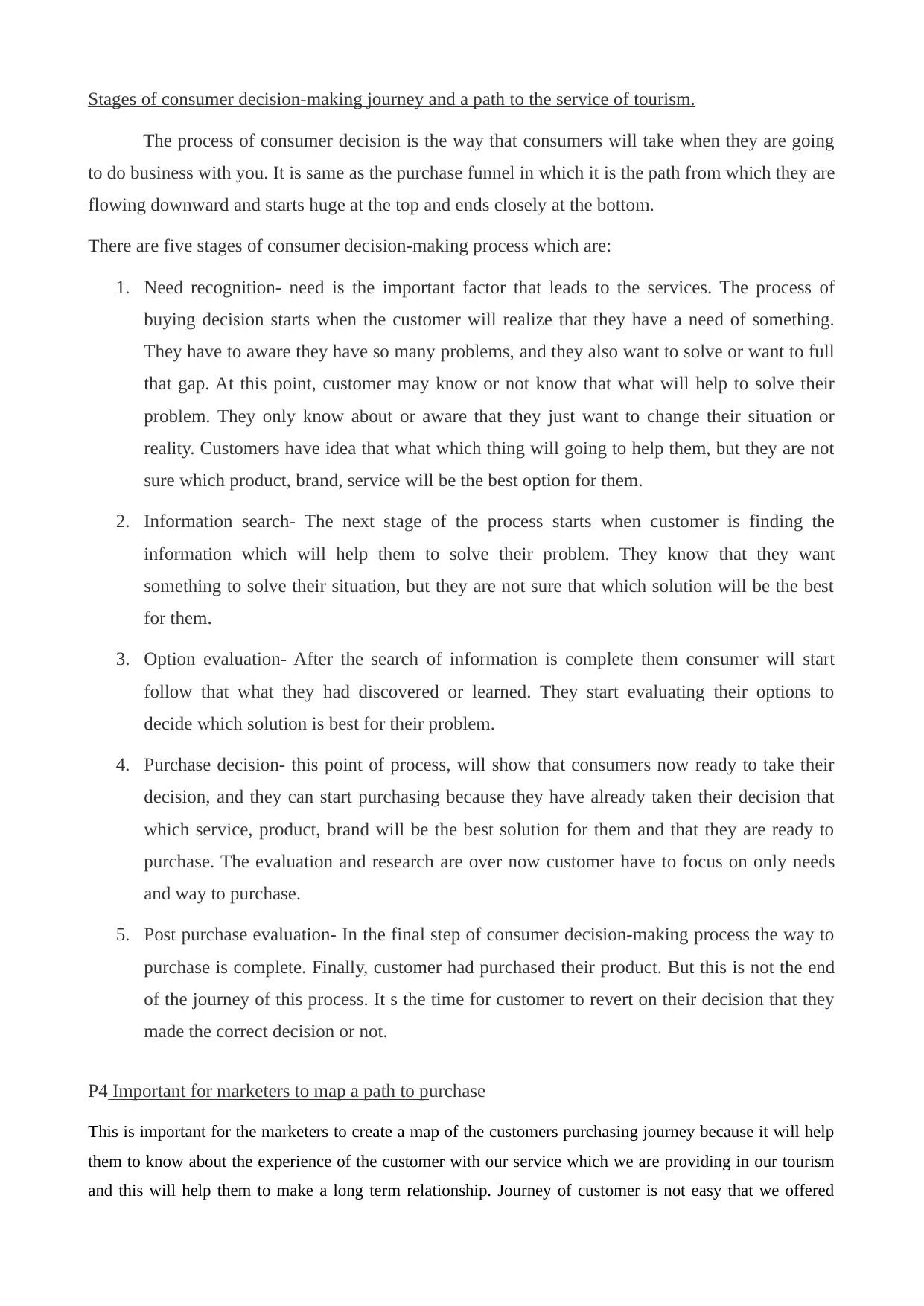
Stages of consumer decision-making journey and a path to the service of tourism.
The process of consumer decision is the way that consumers will take when they are going
to do business with you. It is same as the purchase funnel in which it is the path from which they are
flowing downward and starts huge at the top and ends closely at the bottom.
There are five stages of consumer decision-making process which are:
1. Need recognition- need is the important factor that leads to the services. The process of
buying decision starts when the customer will realize that they have a need of something.
They have to aware they have so many problems, and they also want to solve or want to full
that gap. At this point, customer may know or not know that what will help to solve their
problem. They only know about or aware that they just want to change their situation or
reality. Customers have idea that what which thing will going to help them, but they are not
sure which product, brand, service will be the best option for them.
2. Information search- The next stage of the process starts when customer is finding the
information which will help them to solve their problem. They know that they want
something to solve their situation, but they are not sure that which solution will be the best
for them.
3. Option evaluation- After the search of information is complete them consumer will start
follow that what they had discovered or learned. They start evaluating their options to
decide which solution is best for their problem.
4. Purchase decision- this point of process, will show that consumers now ready to take their
decision, and they can start purchasing because they have already taken their decision that
which service, product, brand will be the best solution for them and that they are ready to
purchase. The evaluation and research are over now customer have to focus on only needs
and way to purchase.
5. Post purchase evaluation- In the final step of consumer decision-making process the way to
purchase is complete. Finally, customer had purchased their product. But this is not the end
of the journey of this process. It s the time for customer to revert on their decision that they
made the correct decision or not.
P4 Important for marketers to map a path to purchase
This is important for the marketers to create a map of the customers purchasing journey because it will help
them to know about the experience of the customer with our service which we are providing in our tourism
and this will help them to make a long term relationship. Journey of customer is not easy that we offered
The process of consumer decision is the way that consumers will take when they are going
to do business with you. It is same as the purchase funnel in which it is the path from which they are
flowing downward and starts huge at the top and ends closely at the bottom.
There are five stages of consumer decision-making process which are:
1. Need recognition- need is the important factor that leads to the services. The process of
buying decision starts when the customer will realize that they have a need of something.
They have to aware they have so many problems, and they also want to solve or want to full
that gap. At this point, customer may know or not know that what will help to solve their
problem. They only know about or aware that they just want to change their situation or
reality. Customers have idea that what which thing will going to help them, but they are not
sure which product, brand, service will be the best option for them.
2. Information search- The next stage of the process starts when customer is finding the
information which will help them to solve their problem. They know that they want
something to solve their situation, but they are not sure that which solution will be the best
for them.
3. Option evaluation- After the search of information is complete them consumer will start
follow that what they had discovered or learned. They start evaluating their options to
decide which solution is best for their problem.
4. Purchase decision- this point of process, will show that consumers now ready to take their
decision, and they can start purchasing because they have already taken their decision that
which service, product, brand will be the best solution for them and that they are ready to
purchase. The evaluation and research are over now customer have to focus on only needs
and way to purchase.
5. Post purchase evaluation- In the final step of consumer decision-making process the way to
purchase is complete. Finally, customer had purchased their product. But this is not the end
of the journey of this process. It s the time for customer to revert on their decision that they
made the correct decision or not.
P4 Important for marketers to map a path to purchase
This is important for the marketers to create a map of the customers purchasing journey because it will help
them to know about the experience of the customer with our service which we are providing in our tourism
and this will help them to make a long term relationship. Journey of customer is not easy that we offered
⊘ This is a preview!⊘
Do you want full access?
Subscribe today to unlock all pages.

Trusted by 1+ million students worldwide
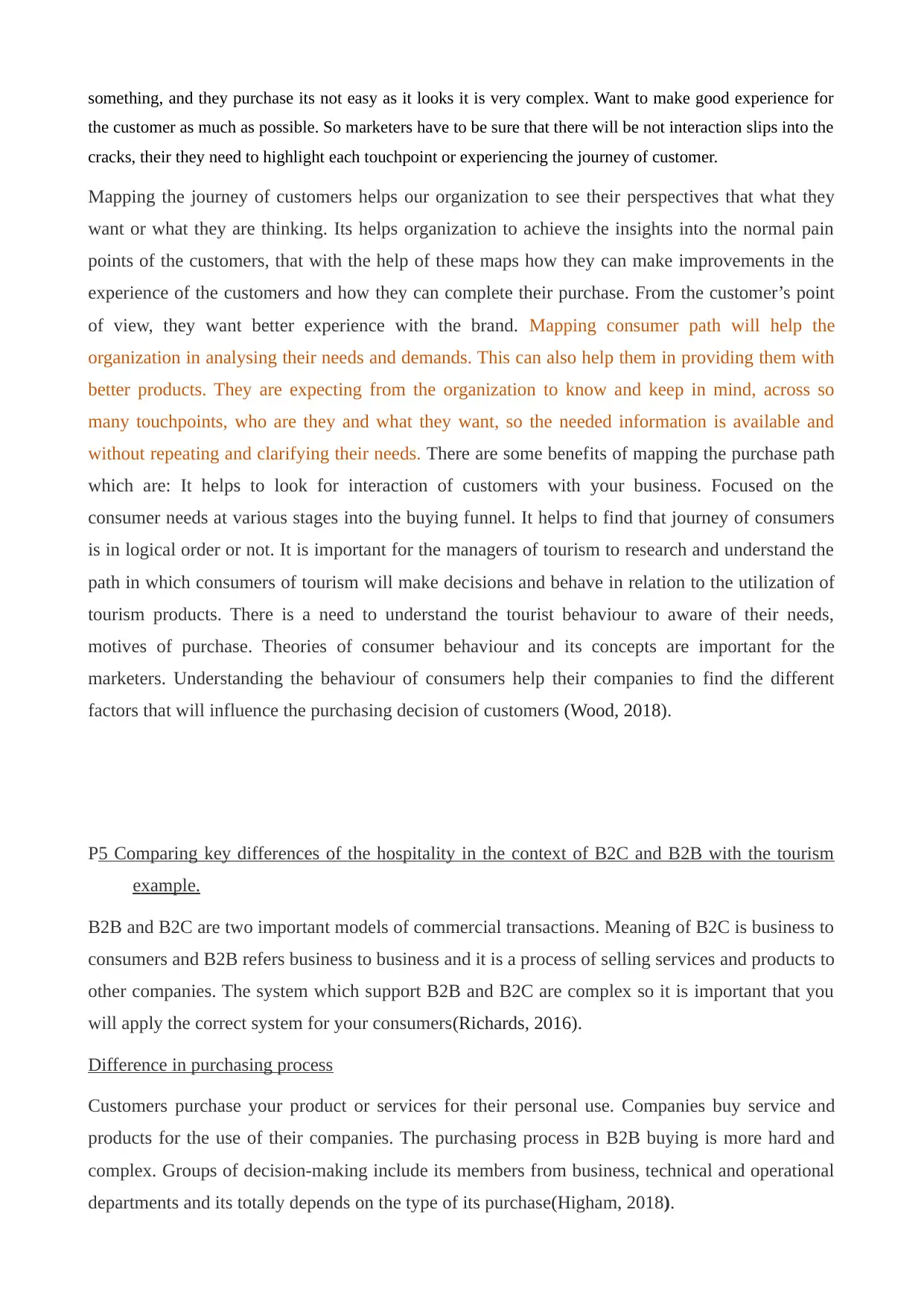
something, and they purchase its not easy as it looks it is very complex. Want to make good experience for
the customer as much as possible. So marketers have to be sure that there will be not interaction slips into the
cracks, their they need to highlight each touchpoint or experiencing the journey of customer.
Mapping the journey of customers helps our organization to see their perspectives that what they
want or what they are thinking. Its helps organization to achieve the insights into the normal pain
points of the customers, that with the help of these maps how they can make improvements in the
experience of the customers and how they can complete their purchase. From the customer’s point
of view, they want better experience with the brand. Mapping consumer path will help the
organization in analysing their needs and demands. This can also help them in providing them with
better products. They are expecting from the organization to know and keep in mind, across so
many touchpoints, who are they and what they want, so the needed information is available and
without repeating and clarifying their needs. There are some benefits of mapping the purchase path
which are: It helps to look for interaction of customers with your business. Focused on the
consumer needs at various stages into the buying funnel. It helps to find that journey of consumers
is in logical order or not. It is important for the managers of tourism to research and understand the
path in which consumers of tourism will make decisions and behave in relation to the utilization of
tourism products. There is a need to understand the tourist behaviour to aware of their needs,
motives of purchase. Theories of consumer behaviour and its concepts are important for the
marketers. Understanding the behaviour of consumers help their companies to find the different
factors that will influence the purchasing decision of customers (Wood, 2018).
P5 Comparing key differences of the hospitality in the context of B2C and B2B with the tourism
example.
B2B and B2C are two important models of commercial transactions. Meaning of B2C is business to
consumers and B2B refers business to business and it is a process of selling services and products to
other companies. The system which support B2B and B2C are complex so it is important that you
will apply the correct system for your consumers(Richards, 2016).
Difference in purchasing process
Customers purchase your product or services for their personal use. Companies buy service and
products for the use of their companies. The purchasing process in B2B buying is more hard and
complex. Groups of decision-making include its members from business, technical and operational
departments and its totally depends on the type of its purchase(Higham, 2018).
the customer as much as possible. So marketers have to be sure that there will be not interaction slips into the
cracks, their they need to highlight each touchpoint or experiencing the journey of customer.
Mapping the journey of customers helps our organization to see their perspectives that what they
want or what they are thinking. Its helps organization to achieve the insights into the normal pain
points of the customers, that with the help of these maps how they can make improvements in the
experience of the customers and how they can complete their purchase. From the customer’s point
of view, they want better experience with the brand. Mapping consumer path will help the
organization in analysing their needs and demands. This can also help them in providing them with
better products. They are expecting from the organization to know and keep in mind, across so
many touchpoints, who are they and what they want, so the needed information is available and
without repeating and clarifying their needs. There are some benefits of mapping the purchase path
which are: It helps to look for interaction of customers with your business. Focused on the
consumer needs at various stages into the buying funnel. It helps to find that journey of consumers
is in logical order or not. It is important for the managers of tourism to research and understand the
path in which consumers of tourism will make decisions and behave in relation to the utilization of
tourism products. There is a need to understand the tourist behaviour to aware of their needs,
motives of purchase. Theories of consumer behaviour and its concepts are important for the
marketers. Understanding the behaviour of consumers help their companies to find the different
factors that will influence the purchasing decision of customers (Wood, 2018).
P5 Comparing key differences of the hospitality in the context of B2C and B2B with the tourism
example.
B2B and B2C are two important models of commercial transactions. Meaning of B2C is business to
consumers and B2B refers business to business and it is a process of selling services and products to
other companies. The system which support B2B and B2C are complex so it is important that you
will apply the correct system for your consumers(Richards, 2016).
Difference in purchasing process
Customers purchase your product or services for their personal use. Companies buy service and
products for the use of their companies. The purchasing process in B2B buying is more hard and
complex. Groups of decision-making include its members from business, technical and operational
departments and its totally depends on the type of its purchase(Higham, 2018).
Paraphrase This Document
Need a fresh take? Get an instant paraphrase of this document with our AI Paraphraser
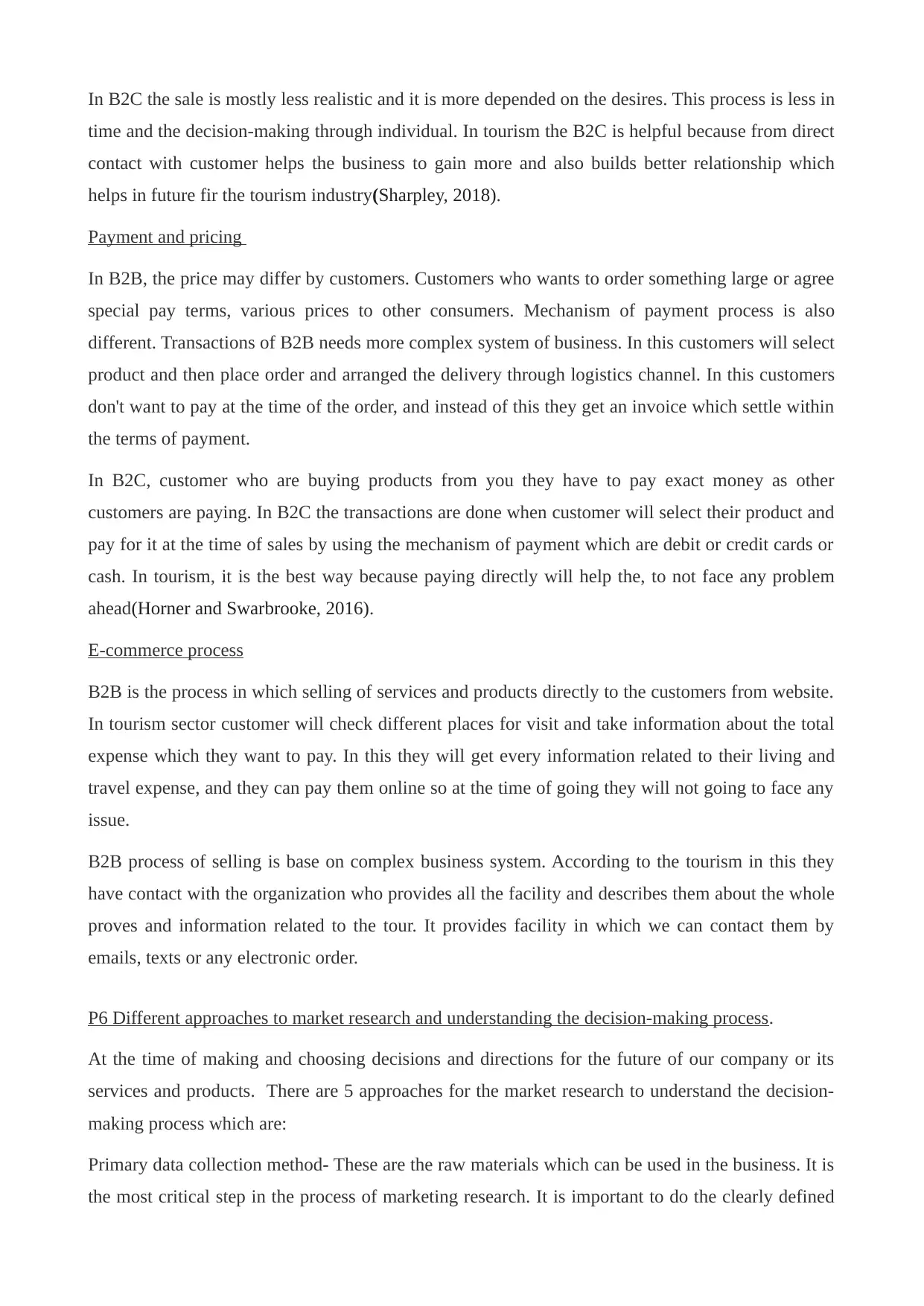
In B2C the sale is mostly less realistic and it is more depended on the desires. This process is less in
time and the decision-making through individual. In tourism the B2C is helpful because from direct
contact with customer helps the business to gain more and also builds better relationship which
helps in future fir the tourism industry(Sharpley, 2018).
Payment and pricing
In B2B, the price may differ by customers. Customers who wants to order something large or agree
special pay terms, various prices to other consumers. Mechanism of payment process is also
different. Transactions of B2B needs more complex system of business. In this customers will select
product and then place order and arranged the delivery through logistics channel. In this customers
don't want to pay at the time of the order, and instead of this they get an invoice which settle within
the terms of payment.
In B2C, customer who are buying products from you they have to pay exact money as other
customers are paying. In B2C the transactions are done when customer will select their product and
pay for it at the time of sales by using the mechanism of payment which are debit or credit cards or
cash. In tourism, it is the best way because paying directly will help the, to not face any problem
ahead(Horner and Swarbrooke, 2016).
E-commerce process
B2B is the process in which selling of services and products directly to the customers from website.
In tourism sector customer will check different places for visit and take information about the total
expense which they want to pay. In this they will get every information related to their living and
travel expense, and they can pay them online so at the time of going they will not going to face any
issue.
B2B process of selling is base on complex business system. According to the tourism in this they
have contact with the organization who provides all the facility and describes them about the whole
proves and information related to the tour. It provides facility in which we can contact them by
emails, texts or any electronic order.
P6 Different approaches to market research and understanding the decision-making process.
At the time of making and choosing decisions and directions for the future of our company or its
services and products. There are 5 approaches for the market research to understand the decision-
making process which are:
Primary data collection method- These are the raw materials which can be used in the business. It is
the most critical step in the process of marketing research. It is important to do the clearly defined
time and the decision-making through individual. In tourism the B2C is helpful because from direct
contact with customer helps the business to gain more and also builds better relationship which
helps in future fir the tourism industry(Sharpley, 2018).
Payment and pricing
In B2B, the price may differ by customers. Customers who wants to order something large or agree
special pay terms, various prices to other consumers. Mechanism of payment process is also
different. Transactions of B2B needs more complex system of business. In this customers will select
product and then place order and arranged the delivery through logistics channel. In this customers
don't want to pay at the time of the order, and instead of this they get an invoice which settle within
the terms of payment.
In B2C, customer who are buying products from you they have to pay exact money as other
customers are paying. In B2C the transactions are done when customer will select their product and
pay for it at the time of sales by using the mechanism of payment which are debit or credit cards or
cash. In tourism, it is the best way because paying directly will help the, to not face any problem
ahead(Horner and Swarbrooke, 2016).
E-commerce process
B2B is the process in which selling of services and products directly to the customers from website.
In tourism sector customer will check different places for visit and take information about the total
expense which they want to pay. In this they will get every information related to their living and
travel expense, and they can pay them online so at the time of going they will not going to face any
issue.
B2B process of selling is base on complex business system. According to the tourism in this they
have contact with the organization who provides all the facility and describes them about the whole
proves and information related to the tour. It provides facility in which we can contact them by
emails, texts or any electronic order.
P6 Different approaches to market research and understanding the decision-making process.
At the time of making and choosing decisions and directions for the future of our company or its
services and products. There are 5 approaches for the market research to understand the decision-
making process which are:
Primary data collection method- These are the raw materials which can be used in the business. It is
the most critical step in the process of marketing research. It is important to do the clearly defined
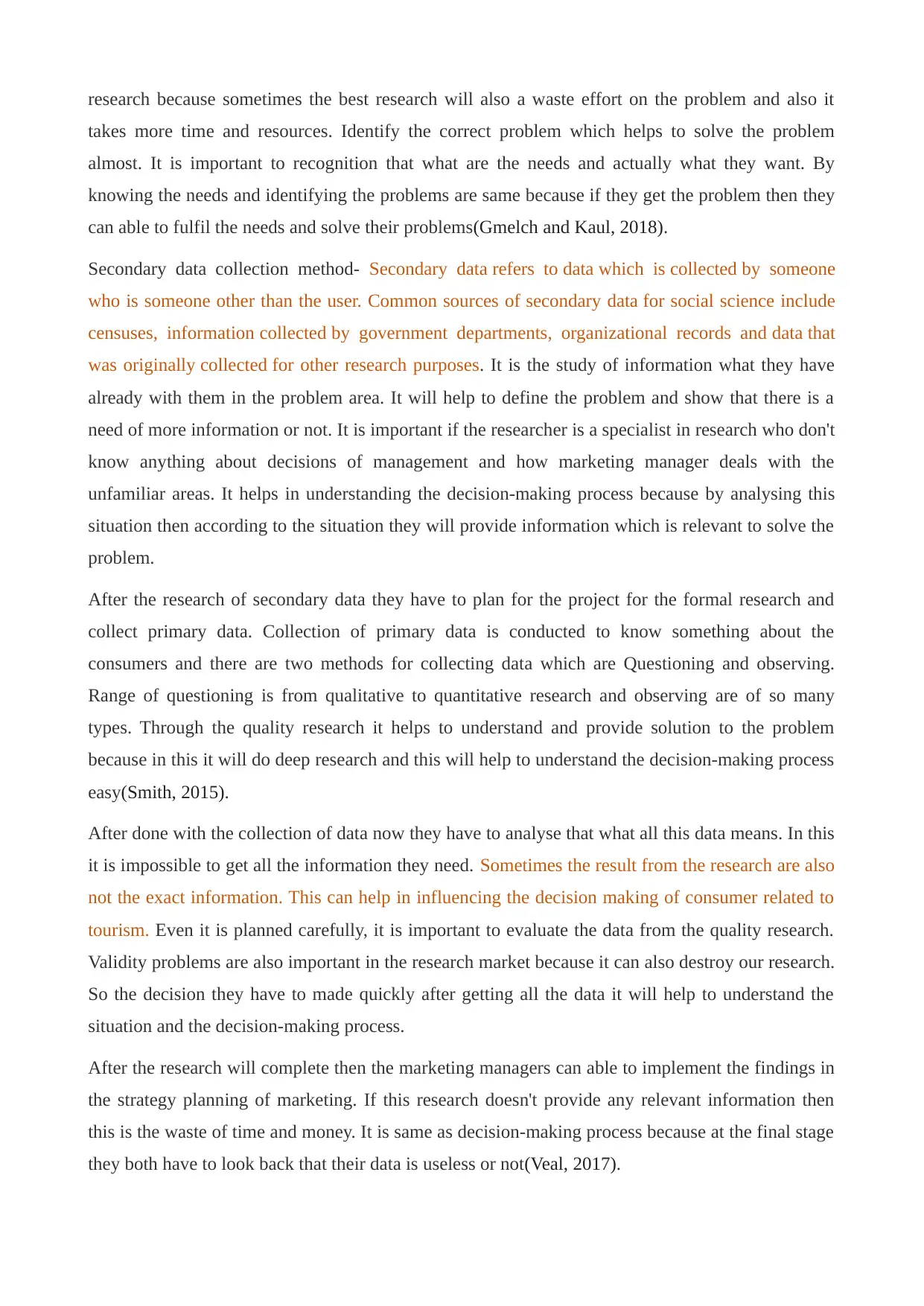
research because sometimes the best research will also a waste effort on the problem and also it
takes more time and resources. Identify the correct problem which helps to solve the problem
almost. It is important to recognition that what are the needs and actually what they want. By
knowing the needs and identifying the problems are same because if they get the problem then they
can able to fulfil the needs and solve their problems(Gmelch and Kaul, 2018).
Secondary data collection method- Secondary data refers to data which is collected by someone
who is someone other than the user. Common sources of secondary data for social science include
censuses, information collected by government departments, organizational records and data that
was originally collected for other research purposes. It is the study of information what they have
already with them in the problem area. It will help to define the problem and show that there is a
need of more information or not. It is important if the researcher is a specialist in research who don't
know anything about decisions of management and how marketing manager deals with the
unfamiliar areas. It helps in understanding the decision-making process because by analysing this
situation then according to the situation they will provide information which is relevant to solve the
problem.
After the research of secondary data they have to plan for the project for the formal research and
collect primary data. Collection of primary data is conducted to know something about the
consumers and there are two methods for collecting data which are Questioning and observing.
Range of questioning is from qualitative to quantitative research and observing are of so many
types. Through the quality research it helps to understand and provide solution to the problem
because in this it will do deep research and this will help to understand the decision-making process
easy(Smith, 2015).
After done with the collection of data now they have to analyse that what all this data means. In this
it is impossible to get all the information they need. Sometimes the result from the research are also
not the exact information. This can help in influencing the decision making of consumer related to
tourism. Even it is planned carefully, it is important to evaluate the data from the quality research.
Validity problems are also important in the research market because it can also destroy our research.
So the decision they have to made quickly after getting all the data it will help to understand the
situation and the decision-making process.
After the research will complete then the marketing managers can able to implement the findings in
the strategy planning of marketing. If this research doesn't provide any relevant information then
this is the waste of time and money. It is same as decision-making process because at the final stage
they both have to look back that their data is useless or not(Veal, 2017).
takes more time and resources. Identify the correct problem which helps to solve the problem
almost. It is important to recognition that what are the needs and actually what they want. By
knowing the needs and identifying the problems are same because if they get the problem then they
can able to fulfil the needs and solve their problems(Gmelch and Kaul, 2018).
Secondary data collection method- Secondary data refers to data which is collected by someone
who is someone other than the user. Common sources of secondary data for social science include
censuses, information collected by government departments, organizational records and data that
was originally collected for other research purposes. It is the study of information what they have
already with them in the problem area. It will help to define the problem and show that there is a
need of more information or not. It is important if the researcher is a specialist in research who don't
know anything about decisions of management and how marketing manager deals with the
unfamiliar areas. It helps in understanding the decision-making process because by analysing this
situation then according to the situation they will provide information which is relevant to solve the
problem.
After the research of secondary data they have to plan for the project for the formal research and
collect primary data. Collection of primary data is conducted to know something about the
consumers and there are two methods for collecting data which are Questioning and observing.
Range of questioning is from qualitative to quantitative research and observing are of so many
types. Through the quality research it helps to understand and provide solution to the problem
because in this it will do deep research and this will help to understand the decision-making process
easy(Smith, 2015).
After done with the collection of data now they have to analyse that what all this data means. In this
it is impossible to get all the information they need. Sometimes the result from the research are also
not the exact information. This can help in influencing the decision making of consumer related to
tourism. Even it is planned carefully, it is important to evaluate the data from the quality research.
Validity problems are also important in the research market because it can also destroy our research.
So the decision they have to made quickly after getting all the data it will help to understand the
situation and the decision-making process.
After the research will complete then the marketing managers can able to implement the findings in
the strategy planning of marketing. If this research doesn't provide any relevant information then
this is the waste of time and money. It is same as decision-making process because at the final stage
they both have to look back that their data is useless or not(Veal, 2017).
⊘ This is a preview!⊘
Do you want full access?
Subscribe today to unlock all pages.

Trusted by 1+ million students worldwide
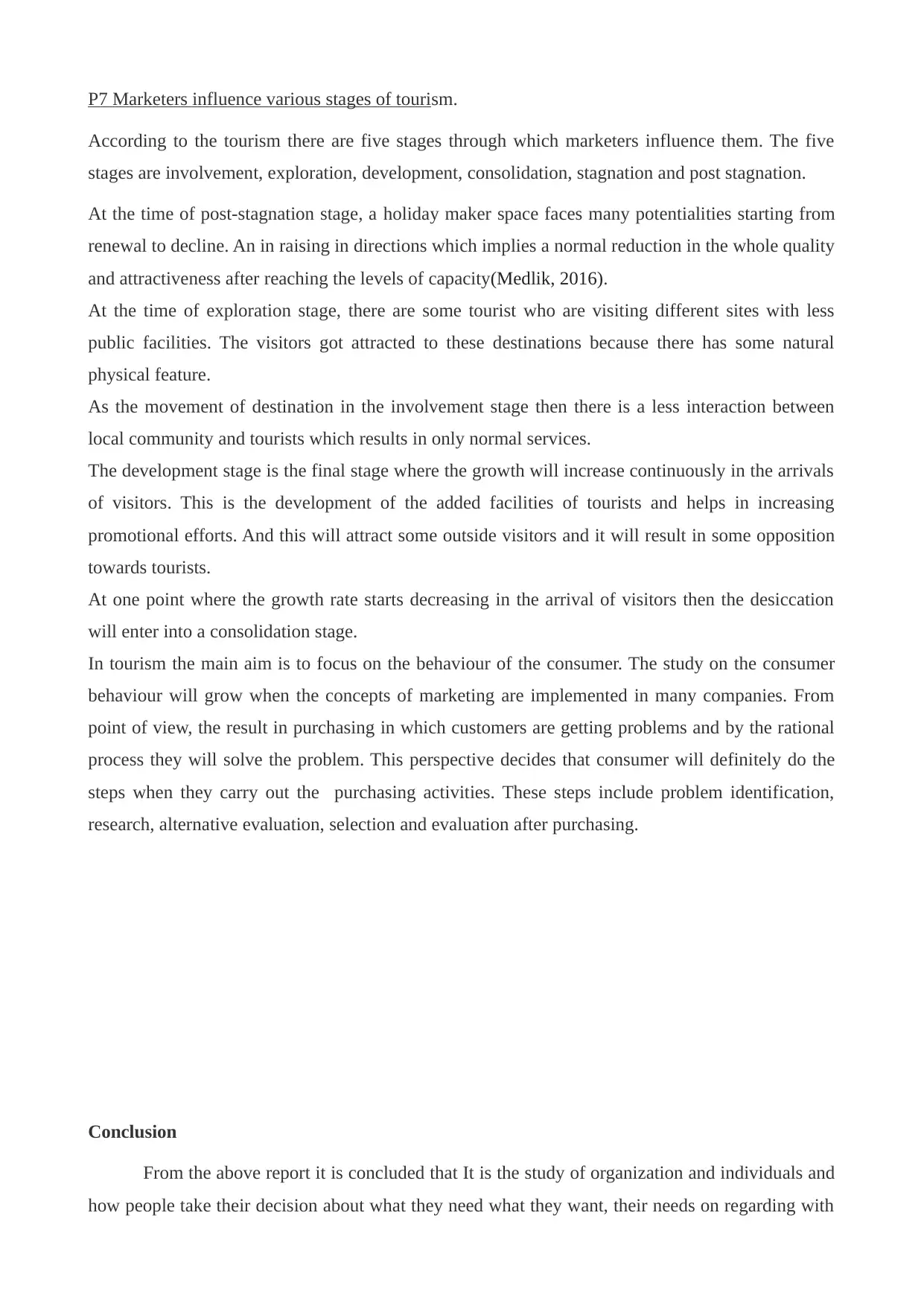
P7 Marketers influence various stages of tourism.
According to the tourism there are five stages through which marketers influence them. The five
stages are involvement, exploration, development, consolidation, stagnation and post stagnation.
At the time of post-stagnation stage, a holiday maker space faces many potentialities starting from
renewal to decline. An in raising in directions which implies a normal reduction in the whole quality
and attractiveness after reaching the levels of capacity(Medlik, 2016).
At the time of exploration stage, there are some tourist who are visiting different sites with less
public facilities. The visitors got attracted to these destinations because there has some natural
physical feature.
As the movement of destination in the involvement stage then there is a less interaction between
local community and tourists which results in only normal services.
The development stage is the final stage where the growth will increase continuously in the arrivals
of visitors. This is the development of the added facilities of tourists and helps in increasing
promotional efforts. And this will attract some outside visitors and it will result in some opposition
towards tourists.
At one point where the growth rate starts decreasing in the arrival of visitors then the desiccation
will enter into a consolidation stage.
In tourism the main aim is to focus on the behaviour of the consumer. The study on the consumer
behaviour will grow when the concepts of marketing are implemented in many companies. From
point of view, the result in purchasing in which customers are getting problems and by the rational
process they will solve the problem. This perspective decides that consumer will definitely do the
steps when they carry out the purchasing activities. These steps include problem identification,
research, alternative evaluation, selection and evaluation after purchasing.
Conclusion
From the above report it is concluded that It is the study of organization and individuals and
how people take their decision about what they need what they want, their needs on regarding with
According to the tourism there are five stages through which marketers influence them. The five
stages are involvement, exploration, development, consolidation, stagnation and post stagnation.
At the time of post-stagnation stage, a holiday maker space faces many potentialities starting from
renewal to decline. An in raising in directions which implies a normal reduction in the whole quality
and attractiveness after reaching the levels of capacity(Medlik, 2016).
At the time of exploration stage, there are some tourist who are visiting different sites with less
public facilities. The visitors got attracted to these destinations because there has some natural
physical feature.
As the movement of destination in the involvement stage then there is a less interaction between
local community and tourists which results in only normal services.
The development stage is the final stage where the growth will increase continuously in the arrivals
of visitors. This is the development of the added facilities of tourists and helps in increasing
promotional efforts. And this will attract some outside visitors and it will result in some opposition
towards tourists.
At one point where the growth rate starts decreasing in the arrival of visitors then the desiccation
will enter into a consolidation stage.
In tourism the main aim is to focus on the behaviour of the consumer. The study on the consumer
behaviour will grow when the concepts of marketing are implemented in many companies. From
point of view, the result in purchasing in which customers are getting problems and by the rational
process they will solve the problem. This perspective decides that consumer will definitely do the
steps when they carry out the purchasing activities. These steps include problem identification,
research, alternative evaluation, selection and evaluation after purchasing.
Conclusion
From the above report it is concluded that It is the study of organization and individuals and
how people take their decision about what they need what they want, their needs on regarding with
Paraphrase This Document
Need a fresh take? Get an instant paraphrase of this document with our AI Paraphraser
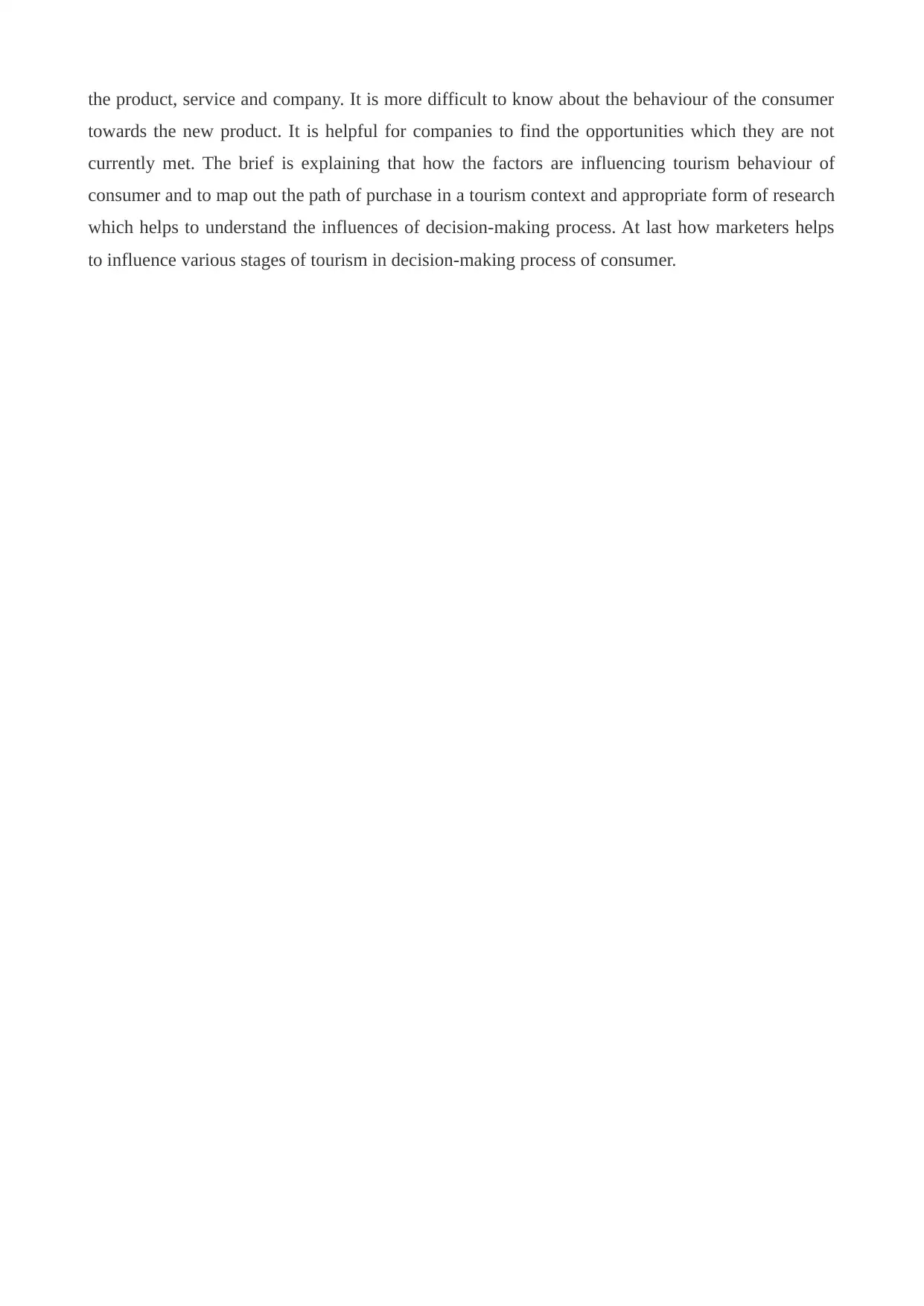
the product, service and company. It is more difficult to know about the behaviour of the consumer
towards the new product. It is helpful for companies to find the opportunities which they are not
currently met. The brief is explaining that how the factors are influencing tourism behaviour of
consumer and to map out the path of purchase in a tourism context and appropriate form of research
which helps to understand the influences of decision-making process. At last how marketers helps
to influence various stages of tourism in decision-making process of consumer.
towards the new product. It is helpful for companies to find the opportunities which they are not
currently met. The brief is explaining that how the factors are influencing tourism behaviour of
consumer and to map out the path of purchase in a tourism context and appropriate form of research
which helps to understand the influences of decision-making process. At last how marketers helps
to influence various stages of tourism in decision-making process of consumer.
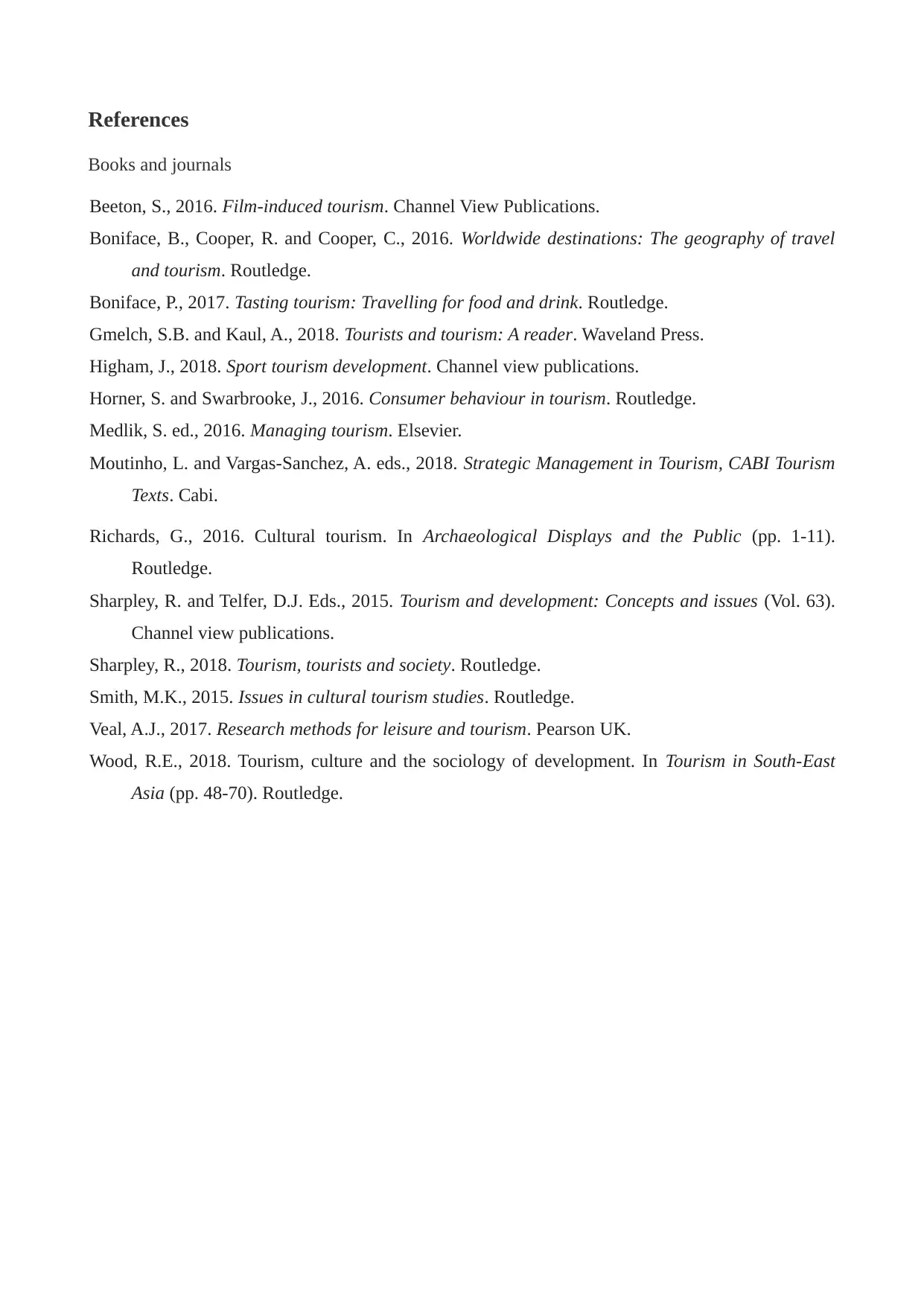
References
Books and journals
Beeton, S., 2016. Film-induced tourism. Channel View Publications.
Boniface, B., Cooper, R. and Cooper, C., 2016. Worldwide destinations: The geography of travel
and tourism. Routledge.
Boniface, P., 2017. Tasting tourism: Travelling for food and drink. Routledge.
Gmelch, S.B. and Kaul, A., 2018. Tourists and tourism: A reader. Waveland Press.
Higham, J., 2018. Sport tourism development. Channel view publications.
Horner, S. and Swarbrooke, J., 2016. Consumer behaviour in tourism. Routledge.
Medlik, S. ed., 2016. Managing tourism. Elsevier.
Moutinho, L. and Vargas-Sanchez, A. eds., 2018. Strategic Management in Tourism, CABI Tourism
Texts. Cabi.
Richards, G., 2016. Cultural tourism. In Archaeological Displays and the Public (pp. 1-11).
Routledge.
Sharpley, R. and Telfer, D.J. Eds., 2015. Tourism and development: Concepts and issues (Vol. 63).
Channel view publications.
Sharpley, R., 2018. Tourism, tourists and society. Routledge.
Smith, M.K., 2015. Issues in cultural tourism studies. Routledge.
Veal, A.J., 2017. Research methods for leisure and tourism. Pearson UK.
Wood, R.E., 2018. Tourism, culture and the sociology of development. In Tourism in South-East
Asia (pp. 48-70). Routledge.
Books and journals
Beeton, S., 2016. Film-induced tourism. Channel View Publications.
Boniface, B., Cooper, R. and Cooper, C., 2016. Worldwide destinations: The geography of travel
and tourism. Routledge.
Boniface, P., 2017. Tasting tourism: Travelling for food and drink. Routledge.
Gmelch, S.B. and Kaul, A., 2018. Tourists and tourism: A reader. Waveland Press.
Higham, J., 2018. Sport tourism development. Channel view publications.
Horner, S. and Swarbrooke, J., 2016. Consumer behaviour in tourism. Routledge.
Medlik, S. ed., 2016. Managing tourism. Elsevier.
Moutinho, L. and Vargas-Sanchez, A. eds., 2018. Strategic Management in Tourism, CABI Tourism
Texts. Cabi.
Richards, G., 2016. Cultural tourism. In Archaeological Displays and the Public (pp. 1-11).
Routledge.
Sharpley, R. and Telfer, D.J. Eds., 2015. Tourism and development: Concepts and issues (Vol. 63).
Channel view publications.
Sharpley, R., 2018. Tourism, tourists and society. Routledge.
Smith, M.K., 2015. Issues in cultural tourism studies. Routledge.
Veal, A.J., 2017. Research methods for leisure and tourism. Pearson UK.
Wood, R.E., 2018. Tourism, culture and the sociology of development. In Tourism in South-East
Asia (pp. 48-70). Routledge.
⊘ This is a preview!⊘
Do you want full access?
Subscribe today to unlock all pages.

Trusted by 1+ million students worldwide
1 out of 13
Related Documents
Your All-in-One AI-Powered Toolkit for Academic Success.
+13062052269
info@desklib.com
Available 24*7 on WhatsApp / Email
![[object Object]](/_next/static/media/star-bottom.7253800d.svg)
Unlock your academic potential
Copyright © 2020–2025 A2Z Services. All Rights Reserved. Developed and managed by ZUCOL.





